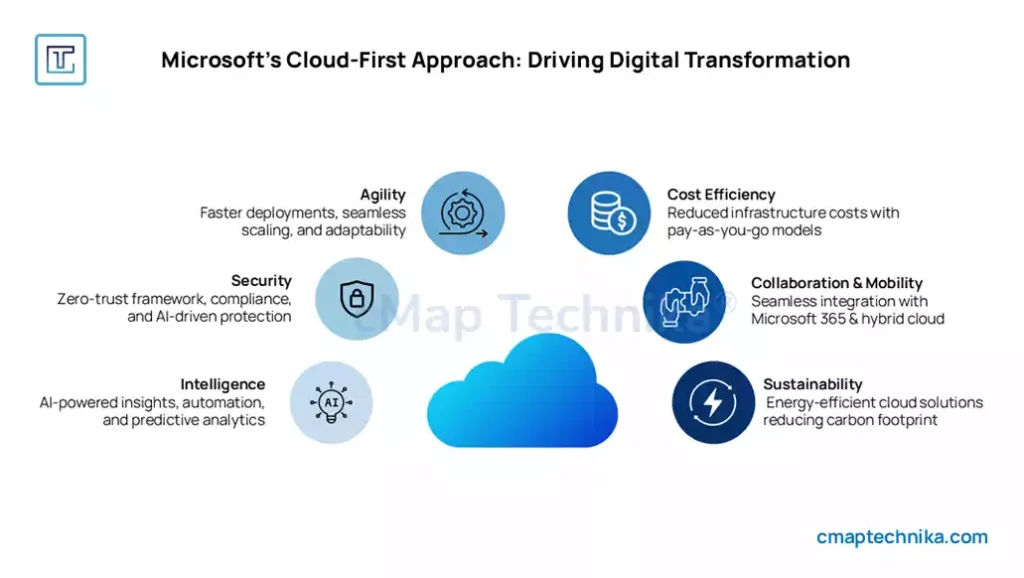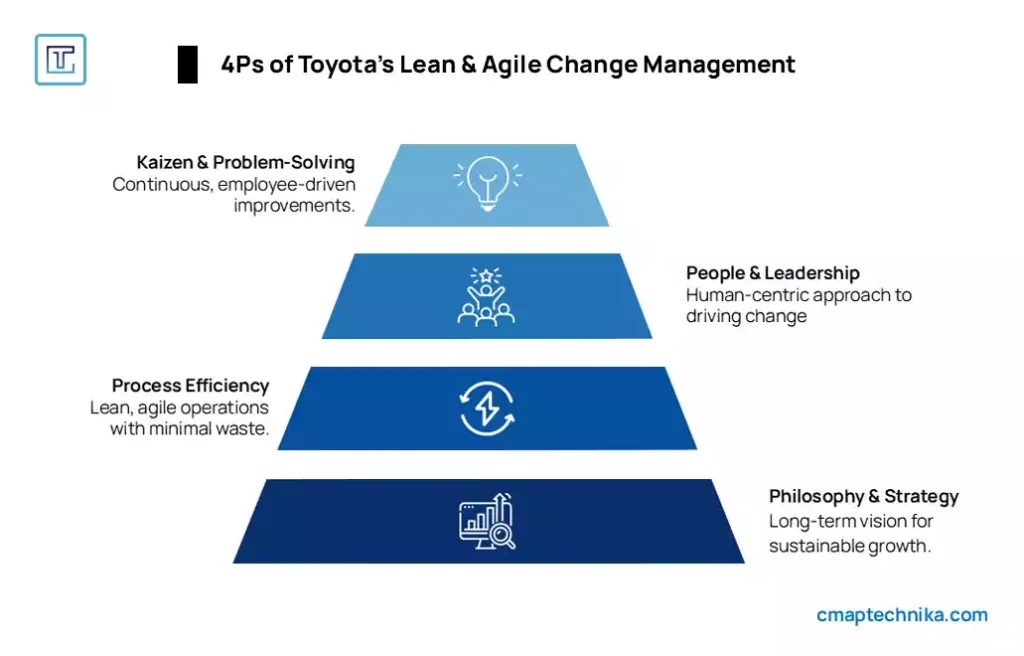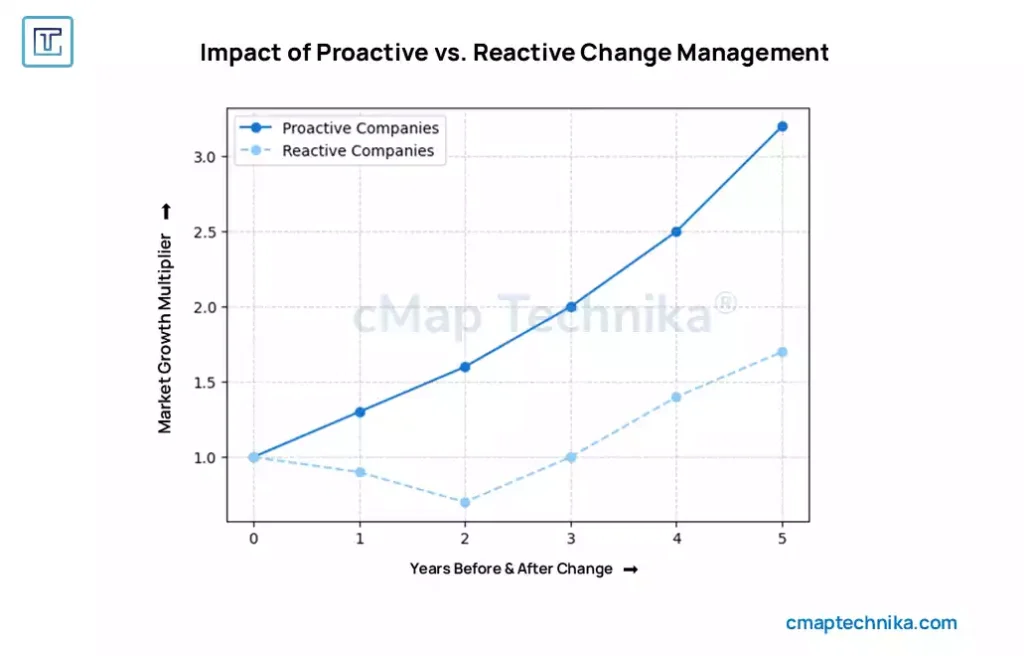Change is the only constant in business, yet managing it effectively remains one of the biggest challenges for organizations. Some companies resist transformation and fade into irrelevance, while others embrace disruption and emerge stronger. What sets these organizations apart? By studying industry titans who have successfully navigated change, we uncover valuable lessons that apply across industries.
Apple: Reinventing the Business Model
In the late 1990s, Apple was on the verge of collapse. Struggling with declining sales, an inconsistent product lineup, and fierce competition from Microsoft, its market share was shrinking rapidly. Many analysts saw little hope for recovery. However, Steve Jobs’ return in 1997 marked the beginning of a bold transformation that redefined not only Apple’s trajectory but the entire technology industry.
Strategic Shifts That Fueled Apple’s Transformation
- Customer-Centric Innovation – Apple shifted from competing on technical specifications to designing products that were intuitive, visually appealing, and seamlessly integrated into users’ lives. The iMac (1998), iPod (2001), iPhone (2007), and iPad (2010) didn’t just meet consumer needs—they created new markets. By focusing on user experience rather than raw performance, Apple reshaped how consumers interacted with technology.
- Ecosystem-Driven Strategy – Rather than selling standalone products, Apple pioneered an interconnected ecosystem. The launch of the App Store (2008), iCloud (2011), and Apple Music (2015) reinforced customer lock-in by making Apple devices more valuable when used together. This shift from a product-based model to a services-driven ecosystem secured long-term customer loyalty and recurring revenue.
- Bold, Risk-Taking Leadership – Jobs’ approach often involved making controversial decisions that challenged industry norms. From removing the floppy disk drive in early iMacs to eliminating the headphone jack on iPhones, Apple frequently took calculated risks to drive innovation. Refusing to support Flash on iPhones (2010) was another defining moment that ultimately helped accelerate the industry’s transition to HTML5.
Key Takeaway
Apple’s transformation underscores the power of rethinking a business model, not just optimizing operations. Companies that build integrated ecosystems rather than isolated products gain a lasting competitive edge, ensuring relevance in an evolving market.
Netflix: Pivoting from DVD Rentals to a Streaming Powerhouse
Netflix’s transformation from a DVD rental service to the world’s leading streaming platform is a textbook example of how businesses can embrace digital disruption. In the early 2000s, Netflix competed directly with Blockbuster, which dominated the home entertainment rental market. However, as consumer preferences shifted toward digital media, Blockbuster failed to adapt, leading to its eventual bankruptcy. In contrast, Netflix foresaw these industry shifts and strategically evolved its business model.
Strategic Shifts That Fueled Netflix’s Transformation
- Data-Driven Decision Making – One of Netflix’s biggest competitive advantages lies in its sophisticated use of artificial intelligence and machine learning. The company leverages user data to personalize content recommendations, enhancing customer engagement and retention. By analyzing viewing habits, Netflix continuously refines its content strategy, ensuring that users stay subscribed.
- Proactive Business Model Shifts – Recognizing the decline of physical media, Netflix shifted to streaming in 2007, well before digital consumption became the industry norm. This early move positioned the company ahead of competitors. Later, to reduce reliance on third-party content, Netflix began producing original series and films, securing a loyal audience with exclusive hits like Stranger Things and The Crown.
- Cultural Adaptability – Unlike legacy media companies that were slow to change, Netflix fosters a culture of innovation and calculated risk-taking. Employees are encouraged to experiment and challenge the status quo, allowing Netflix to pivot quickly when market conditions evolve. This internal agility has enabled the company to continuously refine its business model, from licensing content to becoming a major content creator.
Key Takeaway
Successful companies don’t just react to industry disruptions—they anticipate them and pivot before change becomes inevitable. Netflix’s evolution highlights the importance of proactive transformation, data-driven insights, and a culture that embraces innovation to maintain a competitive edge in a rapidly shifting market.
Microsoft: From Software Giant to Cloud Leader

Microsoft was the undisputed leader of the PC era, dominating with its Windows operating system and Office suite. However, as the tech landscape shifted toward mobile and cloud computing, the company struggled to maintain relevance. Its attempts to compete in the mobile space, including the Windows Phone, fell flat. Meanwhile, cloud-based solutions from competitors like Amazon Web Services (AWS) and Google Cloud gained traction, challenging Microsoft’s dominance.
The turning point came with the appointment of Satya Nadella as CEO in 2014, who spearheaded a radical transformation that positioned Microsoft as a cloud-first company and redefined its strategic vision.
Strategic Shifts That Fueled Microsoft’s Transformation
- Cloud-First Approach – Recognizing the limitations of its traditional software licensing model, Microsoft aggressively pivoted to cloud computing. Azure became the core of its business strategy, allowing enterprises to leverage scalable, cloud-based solutions. This shift diversified revenue streams and reduced reliance on one-time software purchases.
- Embracing Collaboration Over Competition – Previously, Microsoft viewed open-source software as a threat, but under Nadella’s leadership, the company adopted a more inclusive approach. It integrated its products with Linux and open-source tools, making Microsoft’s ecosystem more accessible and fostering partnerships rather than competition.
- Cultural Transformation – Nadella reshaped Microsoft’s internal culture, moving away from rigid corporate hierarchies to foster a growth mindset. He emphasized continuous learning, experimentation, and adaptability, making the company more agile in responding to market changes. This cultural shift allowed Microsoft to embrace innovation rather than resist it.
Key Takeaway
Organizational culture is just as important as strategic decisions. Companies that prioritize adaptability, collaboration, and a growth mindset can successfully navigate industry shifts and drive lasting transformation. Microsoft’s resurgence as a cloud leader proves that even tech giants must reinvent themselves to stay relevant.
Toyota: Mastering Lean and Agile Change Management

Toyota has built a reputation for excellence in manufacturing and innovation, enabling it to remain one of the most dominant forces in the global automotive industry. Unlike many corporations that rely on drastic overhauls during times of crisis, Toyota has mastered the art of incremental, sustainable change through its lean manufacturing philosophy.
Toyota’s Toyota Production System (TPS) is widely regarded as a benchmark for operational efficiency, reducing waste while maximizing productivity. This approach has allowed the company to adapt to market changes without sacrificing stability or quality.
Strategic Approaches to Change Management
- Kaizen (Continuous Improvement) – Toyota fosters a culture where every employee, from factory workers to executives, is encouraged to identify inefficiencies and suggest improvements. This bottom-up approach ensures that innovation is an ongoing process rather than a one-time initiative.
- Flexibility in Production – By implementing the just-in-time (JIT) manufacturing model, Toyota minimizes waste while ensuring that production aligns with real-time demand. This agility allows the company to adjust quickly to supply chain disruptions and shifting market conditions, giving it a competitive advantage in an unpredictable industry.
- Human-Centric Leadership – Toyota invests heavily in its workforce through training programs, leadership development, and employee empowerment initiatives. Employees are encouraged to take ownership of processes and drive innovation from within, ensuring that change is not dictated from the top down but instead embraced across all levels.
Key Takeaway
Sustainable change isn’t about making radical, short-term shifts—it’s about fostering a culture of continuous improvement. Toyota’s ability to embed adaptability into its organizational DNA has ensured long-term success, proving that small, incremental changes can have a transformative impact over time.
Amazon: Relentless Reinvention and Customer Obsession
Amazon’s transformation from a simple online bookstore into a global e-commerce and cloud computing giant is a testament to its relentless focus on innovation and customer-centric strategy. By continuously reinventing itself, Amazon has expanded beyond retail into diverse industries, including cloud computing (AWS), digital entertainment (Prime Video), artificial intelligence (Alexa), and even physical retail (Whole Foods, Amazon Go).
Amazon’s success is not driven by any single product but by a deeply ingrained culture of adaptability, experimentation, and customer obsession. Its ability to anticipate trends and pivot quickly has allowed it to disrupt multiple industries while maintaining dominance.
Strategic Approaches to Transformation
- Customer-Driven Innovation – Amazon places customer needs at the core of its decision-making. Features such as one-click ordering, personalized recommendations, same-day delivery, and Prime membership benefits are all designed to enhance convenience and customer satisfaction. Jeff Bezos’ philosophy of “customer obsession” ensures that innovation is driven by what benefits the customer, rather than internal convenience.
- Diversification & Expansion – Unlike companies that focus solely on their core product, Amazon constantly expands into new markets and industries. The launch of Amazon Web Services (AWS) revolutionized cloud computing, while ventures like Prime Video and Kindle reshaped entertainment and digital publishing. Amazon’s acquisition of Whole Foods signaled its ambition to transform physical retail as well.
- Experimentation Culture & Risk-Taking – Amazon embraces a culture of experimentation and calculated risk-taking. It is willing to test and iterate rapidly, knowing that not all ideas will succeed. Concepts like Alexa, drone-based delivery, cashier-less Amazon Go stores, and even failed ventures like the Fire Phone exemplify Amazon’s commitment to pushing boundaries while learning from failures.
Key Takeaway
The most successful organizations do not wait for change—they actively shape it. Amazon’s willingness to experiment, fail, and evolve has allowed it to stay ahead of the competition. By embedding adaptability and a customer-first mindset into its DNA, Amazon ensures that it remains at the forefront of innovation across multiple industries.
What Can Businesses Learn from These Titans?

- Be Proactive, Not Reactive – Companies that anticipate and embrace change before being forced to have a significant competitive advantage.
- Leverage Technology for Agility – AI, data analytics, and automation enable businesses to adapt quickly and manage transformation effectively.
- Foster a Culture of Innovation – Employees should feel empowered to experiment, take risks, and contribute to change initiatives.
- Put the Customer First – Business transformation should always align with improving customer experiences and satisfaction.
- Leadership Matters – A clear vision and strong leadership are critical in steering an organization through successful change.
Embracing Change for Long-Term Success
Organizations that endure and thrive are those that proactively embrace reinvention rather than waiting for disruption to dictate their future. Change management is not just about adapting to challenges—it is a strategic driver of innovation, resilience, and industry leadership.
Regardless of size or sector, every organization must confront a fundamental question: Are we prepared for the next wave of disruption? The answer determines whether a business remains competitive or fades into obscurity.
A successful transformation requires more than just new technology or updated processes—it demands a clear vision, agile leadership, and a culture that fosters continuous evolution. Businesses that anticipate and actively shape change position themselves for sustained growth and long-term impact.
The ability to navigate and lead change is the defining trait of industry pioneers. Those who embrace transformation today will be the leaders of tomorrow.






